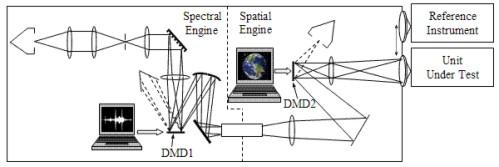Summary
Detecting climate data with remote sensing instruments, providing state-of-the-art surveillance imagery for security and defense, or getting the most out of medical imagers requires excellent knowledge of the sensor's performance. One of the challenges faced by scientists and engineers developing these instruments is effectively evaluating their performance. To address this challenge, we are developing the Hyperspectral Image Projector (HIP). The HIP will enable performance evaluation of cameras and other imaging instruments using realistic scenes.
Description

Remote sensing instruments and medical imagers are designed to take images composed of many spectral bands, not just the minimum three components used by common digital cameras (i.e., red, green, and blue). These images are referred to as hyperspectral because each pixel contains information for hundreds or thousands of narrow spectral bands. The purpose of the Hyperspectral Image Projector (HIP) is to enable scientists to project hyperspectral images into sensors, simulating realistic scenes both spectrally and spatially, for performance testing and evaluation of the sensor instruments in the laboratory. For example, by using the HIP to test satellite sensor performance in controlled laboratory settings, scientists can alleviate expensive field testing, allow better separation of environmental effects from instrument effects, and enable system-level performance testing and validation of space-flight instruments prior to launch. Many realistic scenes of interest for testing defense and security sensors would be very difficult or dangerous to set up outside, but can be relatively easily simulated and projected into the sensors by the HIP. Similarly, tissue phantoms used to test medical optical and infrared imaging instruments are difficult to maintain and disseminate with known properties, whereas the HIP can present repeatable digital versions of tissue phantoms to these instruments.
The design of the HIP system is similar to commercially available Digital Light Processing (DLP) projections systems. In DLP systems, the projected image is made from a composite of grayscale images representing each of the RGB colors (red, green, and blue). The individual grayscale images are generated by focusing light through a rotating multicolored filter (to obtain the spectral component) and illuminating a digital micromirror device (to obtain the spatial component). When the grayscale images are projected and combined at typical video frame rates, the result is a full RGB-color image. In contrast to the DLP system, the HIP system has the ability to project composites of numerous spectra. Instead of using a filter as in the DLP system, the spectral components for the HIP system are generated with a spectral engine, composed of dispersive optics and a spatial light modulator such as a digital micromirror device (DMD) or a liquid crystal spatial light modulator. The spatial engine, composed of a second spatial light modulator, then determines the spatial component for each spectral component. Synchronized operation of both engines ensures that each spectral component is projected sequentially in the correct proportions in each spatial region to create a time-averaged hyperspectral image.

The design concept for the Hyperspectral Image Projector (HIP)
The advantage of the HIP system is not only its ability to project realistic, spectrally and spatially complex scenes, but also the user's ability to arbitrarily define and control the spectral distributions at each pixel in the spatial image. For example, the HIP can alter certain spectral components to reflect changing scenes. This means that HIP can be used to test imagers under a wide range of conditions and for a variety of applications.
Major Accomplishments
We have developed a prototype HIP system using a supercontinuum light source covering the spectral range from 450 nm to 2400 nm. It has 2 nm spectral resolution in the visible-near-infrared (VNIR), and can match natural spectra to within about 1 % full scale as shown in the figure below (measurements at the HIP output are in red, and the target spectra are shown in other colors). Similar matching to hemoglobin spectra of varying oxygen concentration for bio-medical optical applications have been achieved. We have developed an efficient method of providing spectral uniformity, and we are currently working on an extension of the HIP down to 350 nm.

For more information see more HIP publications.

